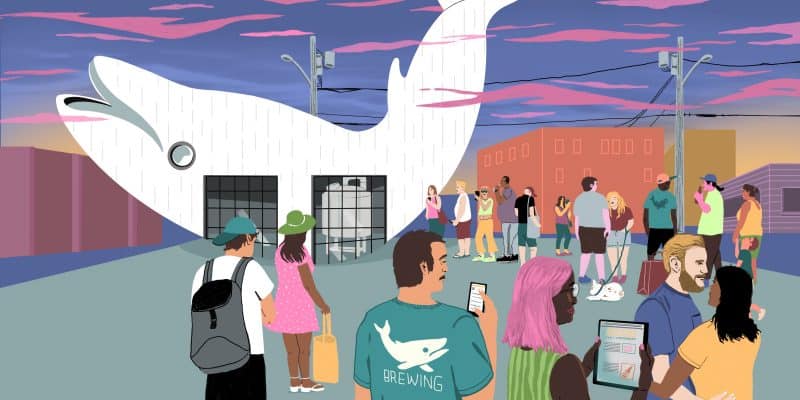A Commentary with Stephen Beaumont
When someday someone writes the history of craft beer in North America, they will no doubt draw attention to the first two decades of the 21st century as the era of the ‘whale.’ For those not familiar with the term, a ‘whale’ – short for ‘great white whale,’ referencing Captain Ahab’s quest in Moby Dick – is what a certain kind of beer aficionado calls a limited release beer that scores plenty of peer points when sampled and, importantly, rated online.
If you’ve spent any amount of time on beer rating sites or beer-related message boards, you will have heard much about whales. They are the beers people go out of their way, sometimes very far out of their way, to get their hands on. Often they are sold at special release days, complete with long line-ups and strict limits on the number of bottles or cans available per person, and sometimes they are the subject of high-profile beer events such as the Dark Lord Days at Indiana’s 3 Floyds Brewing and Cigar City’s Hunahpu’s Day in Florida.
Whales are communally served at tasting parties, known as ‘bottle shares,’ traded through the mail (for other whales, of course!), and even sold on the grey market at occasionally vastly inflated prices. The rarer the release, the more coveted it is.
For many modern breweries, the sale of whales and other special release beers has become a cornerstone of their business plan, with one brewery owner even kidding to me that he was going to call one of his limited release beers Fiscal Responsibility. Which begs the question of what happens when the whales stop selling.
While some cynics may deny that such a thing will ever happen, it’s not really difficult to imagine. In our present climate of high interest rates and higher inflation, everyone’s dollars are stretched more and more these days, potentially to the point that standing in line to buy a couple of bomber bottles or a four-pack of cans of a prized but pricey beer might not seem quite so attractive a proposition. And if that comes to pass, well, as posited above, what then?
One solution for special release-centric breweries would be to take a page from the history books, of more specifically, the Boston Beer Company’s history books. Because long before there were multiple Imperial stout variants and triple and quadruple IPAs, there were the Sam Adams seasonal and special releases.
In the early days of craft brewing, inflated portfolios of dozens or even hundreds of brands were very much the exception rather than the rule, with most breweries reliant heavily on the sales of one or a few core brands – Sierra Nevada’s Pale Ale, Brooklyn Brewery’s Lager, Deschutes’ Mirror Pond and Black Butte, and of course, Samuel Adams Boston Lager. Seasonal and special releases – the latter of which were few and far between – were meant to capitalize on seasonally appropriate styles and, more importantly, put the brewery’s name in front of the consumer, so as to promote sales of the core brands. And no one did this better than Boston Beer.
When Jim Koch’s brewery released highly anticipated seasonals like its Scotch Ale and Old Fezziwig, it was less about selling those particular beers than it was promoting the Samuel Adams name, and when Boston Beer got into its beer strength war with Dogfish Head, it was less about making money on the high alcohol beers – Koch once told me that he made precious little on releases like Millennium and Utopias, despite their high price tags – than it was about, again, keeping the brewery names front and centre in the public’s consciousness.
Such a strategy is, of course, dependent upon a brewery having one or more flagship brands, which these days is anathema for many breweries. However, as we saw numerous breweries pivot in various ways over the course of the pandemic, including some devolving from regular and multiple releases to a tighter core range of brands, we know that one of the strengths of craft breweries is their nimbleness and ability to change course on a dime.
Another option for the special release set is to pursue the licensee market. Since most whales and near-whales are distributed almost exclusively through the brewery’s taproom, they are very seldom seen at bars and restaurants. But with beer consumers flocking back to bars this summer, there is a very real opportunity to sell beer in greater but still exclusive volumes on-premise.
One example of this strategy to look to is northern California’s Russian River, whose annually brewed Pliny the Younger most certainly qualifies as a whale. But while Russian River does hold very well-attended launch parties for the Younger at its two brewery pubs, it also releases kegs to a select number of establishments which, in turn, hold their own special Pliny day or days, sometimes featuring a robust mix of other Russian River beers at the same time.
If confined to a strict geographical region, the latter strategy may require a show of good faith such as restricting the brewery taproom hours so that it doesn’t compete quite so directly with locals bars, but sometimes the best way to grow sales outward is to decrease them at the source. It’s innovative thinking, and what just might be required if the special release love eventually does start to fade.



